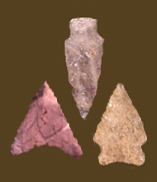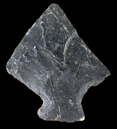
|
PERKIOMEN
Chronology The Perkiomen point dates to the end of the Late Archaic period. Radiocarbon dates associated with the Perkiomen in the upper Delaware River Valley range from 1720 +/- 120 BC to 1500 +/- 120 BC (approximately 2025-1700 BC in calendar years) (Kinsey 1972). Others suggest it has a broader date range of roughly 2000 to 1500 BC (2450- 1700 BC in calendar years) (Truncer 1990; Custer 1996a; Wall et al. 1996). Description Blade: The blade is thin and approximately equilateral in shape. It is often somewhat out of center in relation to the stem. A medial ridge, if present, is usually just on one face, with the other face flat. Blade edges are frequently asymmetrical, convex near the tip, and slightly convex to concave elsewhere on the blade. The shoulders can form obtuse or acute angles, with one shoulder frequently barbed. Haft Element: The base is usually convex, but can be straight; it is almost never concave. When compared to the blade, the expanding stem is quite small, with rounded corners. The edges of the stem and base are often ground smooth, and grinding can be found on the portions of the shoulder closest to the stem. Size: Length ranges from 24 to 229 mm, with most between 51 and 102 mm. Width ranges from 21 to 102 mm, with most under 38 mm. Thickness ranges from 3 to 9 mm. Some studies suggest that the size of Perkiomens correlates with their material type or the distance the point traveled from its lithic source location, with larger points often found closer to quarries (Truncer 1990). Technique of manufacture: The point is often shaped from a large oval or pentagonal preform. Soft percussion produced wide and shallow flaking, with some pressure flaking around the haft. The flaking results in a cross section that is essentially flat. Material: In a sample of 12 Perkiomen points from the lower Patuxent drainage, Steponaitis (1980) reported that 50% were quartz, followed by rhyolite (30%), quartzite (10%), and chert (10%). In the Monocacy River drainage, 85% of 13 Perkiomens were rhyolite, with 15% jasper (Kavanagh 1982). Jasper Perkiomen points predominate in the middle Potomac River Valley, but rhyolite was also used (Hranicky 2002). In Delaware, they are commonly made from jasper (Custer 1996a). Along the Nottoway River in Virginia, the chert and jasper Perkiomen points were generally made from heat-altered material (McAvoy and McAvoy 1997) Discussion The Perkiomen is part of a class of points known as “broadspears.” However, experimental study of Perkiomen use has found that they functioned as both projectiles (possibly fish spears) and knives. The knives tended to have wider blades than the projectiles, but there was morphological overlap between the two, complicated by factors such as re-sharpening (Truncer 1990; see also Staats 1986). Broken Perkiomens were often re-used as scrapers and other tools (Kraft 1990). An association of “killed” or broken Perkiomen points with cremation burials has also been noted (McLearen 1991). Defined in Literature This type was originally defined by Witthoft (1953), based on points recovered from eastern Pennsylvania. References |
![]()
Search by Shape:
(See Projectile Point Typology) |

|
Thank you for visiting our website. If you have any
questions, comments, Copyright © 2002 by |

|

 Defining Attributes
Defining Attributes